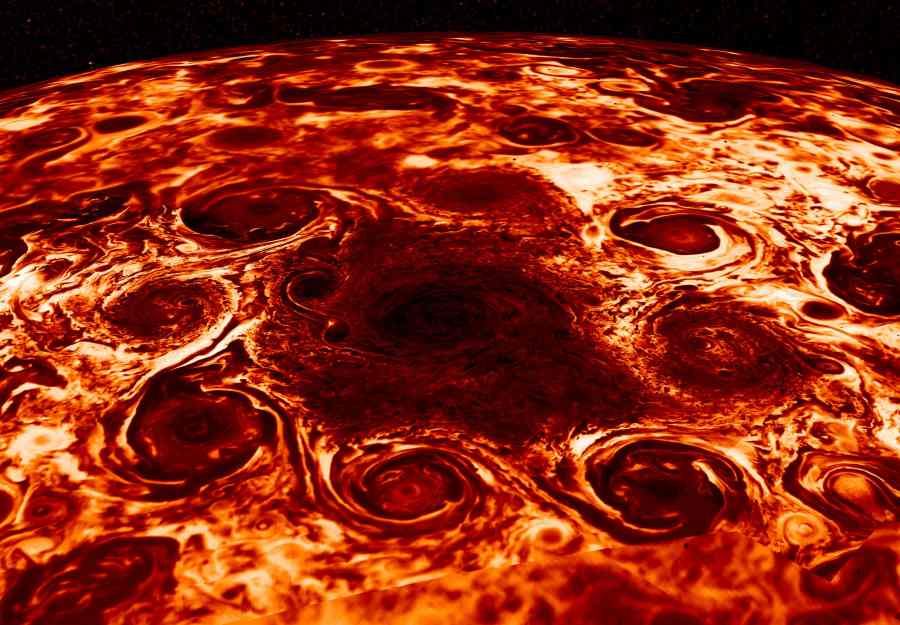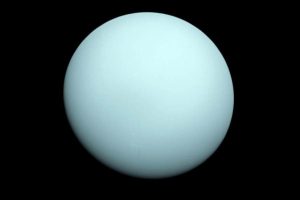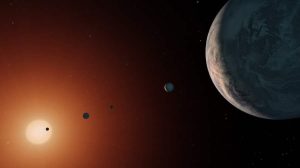New discoveries on Jupiter. Geometric cyclones around the poles

New discoveries on Jupiter. Geometric cyclones around the poles
The orange and white stripes that characterize Jupiter’s outer atmosphere extend thousands of miles deep into the gas giant, with geometric groups of cyclones forming at its poles. The new discoveries were made through analysis of data provided by the Juno probe.
– Data obtained thanks to the Juno probe show us a brand new Jupiter. They are changing our previous knowledge of the giant planets scattered around the Universe – said Scott Bolton of the Southwest Research Institute, ktory directs the research of the Juno mission.
W „Nature” were recently published four scientific articles on new discoveries on Jupiter. The papers focus on the structure of the planet’s atmosphere under a visible cloud layer and the surprising discovery of clusters of cyclonesoIn Jupiter’s surrounding poles. All this thanks to the Juno mission.
Juno entered the gas giant’s orbit in August 2016. According to the original plan, after dwochr laps the orbit tightening maneuver was to occur and the probe was to be in a 14-day orbit. However, due to a malfunction related to the helium valves in the head engineownym of the probe, NASA engineers decided not to undertake this risky maneuver and Juno is currently in an extended 53-day orbit and will stay there until the end of the mission.
– Juno’s probe systems are so technically advanced that measurement capabilities have been improved by an order of magnitude when it comes to precision – admitted Bolton. This increased accuracy allowed scientists to detect an asymmetry in Jupiter’s structure at depths of nearly 3,000 kilometersow.
– This discovery surprised the entire teamoł. Data from Juno show that the jet currents crossing Jupiter extend well below the depth where sunlight reaches, meaning that something other than weather may be driving these forces – Bolton added.
Overall, Jupiter’s jets contain about 1 percent of the gas giant’s mass. This means that a mass equivalent to about three earths moves wokoJupiter in the form of these streams. On Earth, the atmosphere is less than a millionth of the planet’s mass.
The research also revealed that underneath the layers of the atmosphere, Jupiter rotates as a hard, rigid body. – In some waysob Jupiter is going from a layer of currentoIn the jet, ktore rotate as gorna layer of clouds to a rigid body at depth, where everything moves together. This passage may have something in commonolarity with Jupiter’s strong magnetic field – Bolton explained.
Scientists hope that the change between atmospheric layers and those more solid, whichore lie below, will be revealed during the remainder of the Juno mission in the next few years.
Another discovery involves geometric arrangementsoin cycloneow at the poles of Jupiter. – Before the Juno mission, scientists knew little about Jupiter’s poles. First of all, because from Earth’s perspective you simply can’t see them. It turns out that Jupiter is barely recognizable when viewed from the pole sideow – noted Bolton.
Images obtained from both a visible light camera and an infrared one showing the poles of the gas giant revealed geometric patterns of powerful cyclonesow. On the poThe northern pole of the eight cyclonesow surrounds one centrally located. All of them are 4000-4600 kilometers in sizeoin diameter. At the South Pole, the central cyclone is surrounded by five others. Southern cyclones are larger, with sizes on the order of 5600-7000 kilometersoin diameter.
– These cyclones are huge. Wind speeds are as high as 350 kilometersow per hour. They seem to exist close together in harmony and are permanent. Surprisingly roThey differ from a single thunderstorm pattern, whichory Cassini probe measured at Saturn’s poles – assessed Bolton.
Jupiter is the solar system‘s largest planet. Its mass is two and poł times the mass of all the other planets in our system. The gas giant has nearly 70 known moonsow. The planet is covered by several layers of clouds, ktore arranged in distinctive stripes visible from our planet. A day on Jupiter lasts about 10 hours.




